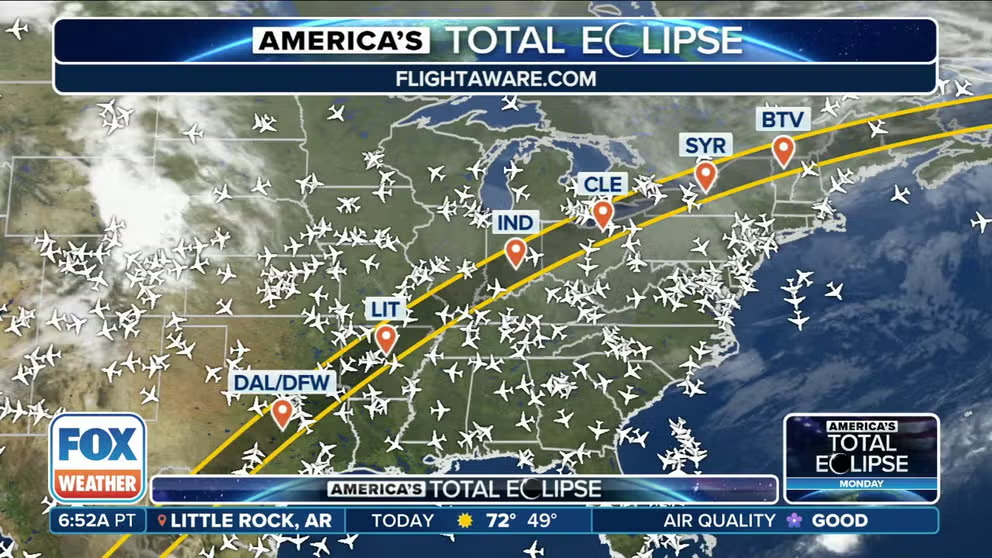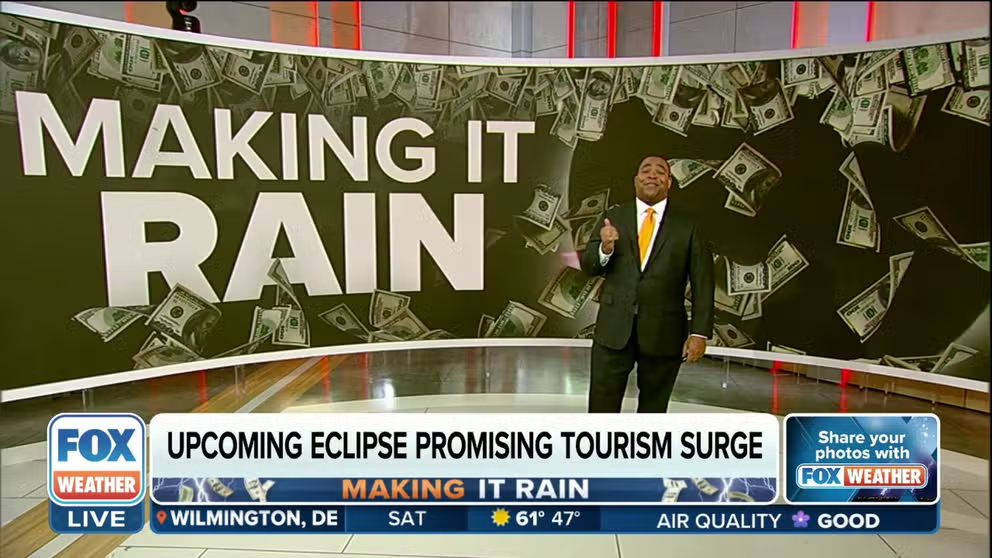FAA warns of impacts to air travel during solar eclipse
More than 30 million Americans are estimated to live in the path of totality, with many millions more expected to travel to the 15 states where the event will be visible. The FAA highlighted airports in Dallas, Indianapolis, and Cleveland as being at risk for delays during the eclipse.
Millions will be flying during the eclipse, possibly leading to travel delays
Meteorologist and pilot J.P. Dice joins FOX Weather to discuss potential effects on air traffic and airports that are around the path of totality during the solar eclipse on Monday.
WASHINGTON - The Federal Aviation Administration is warning travelers and pilots the total solar eclipse in April could snarl air traffic, especially at airports located in what is known as the path of totality.
The FAA posted what it called "special air traffic procedures" on its website Thursday that listed the possible impacts on the industry and what airports could be subject to operational changes.
Hundreds of airports are either located in the path totality or are close enough in proximity to service aviators interested in the phenomenon.
"What a lot of people may not realize, there are a lot of private aircraft and pilots that are planning on viewing the eclipse and viewing totality from that area from the sky," meteorologist and pilot JP Dice told FOX Weather. "So you have a lot of airplanes converging on one spot, and that's going to run into some air traffic issues. There's only so much room out there. So we could be. If you're an airline traveler on Monday running into some delays."
The bulletin includes major airports such as Dallas-Fort Worth International, Indianapolis International and Cleveland International.
"I think the biggest clearly is, is Dallas being a hub for Southwest and American Airlines as we move toward St. Louis (and) talking about Cleveland, Indianapolis on toward Buffalo. Those are not necessarily significant airline hubs, but we could be looking at problems there because those are larger airports," Dice said. "Now in terms of air traffic control. What they're doing, they may end up limiting some of the aircraft that can actually come in there. And that includes private aircraft. And also putting other aircraft in the lanes, holds, reroutes – a lot of different things that would not be typical on a normal airline day. Some of the actions they would do would be similar to if you were going to have bad weather in a certain area, you could only handle so many aircraft."
Starting before noon on April 8, the Moon will completely block the Sun for several minutes, leading to temporary darkness that will begin over Texas and travel over 15 states.
All of the Lower 48 will be subject to a partial event, but communities that are under what space experts call the umbra will have prime viewing of the narrow path of totality.
More than 30 million Americans are estimated to live in the path, with millions more expected to travel to states such as Texas, Ohio and New York to see the spectacle.
TEXAS COUNTY DECLARES STATE OF EMERGENCY AHEAD OF GREAT NORTH AMERICAN ECLIPSE
The event is similar to an eclipse that happened back in 2017, when the Sun was temporarily shielded by the Moon from coast to coast.
The National Air Traffic Controllers Association reported air traffic during the previous event increased 20-40% at control centers that were in range of the path of totality.
The association said Indianapolis Center saw a 36% increase, its Seattle Center reported an uptick of 33% and Kansas City saw a 35% jump when compared to typical workday traffic.
While commercial traffic stays within a manageable range, air traffic controllers said the addition of civilian aircraft causes numbers to exceed holiday traffic volumes.
The combination of any type of weather systems on top of the increased traffic can lead to significant delays, like what happened to Chicago’s main airports during the event nearly seven years ago.

This graphic shows the best cities in the path of totality during the total solar eclipse on April 8, 2024.
(FOX Weather)
HOW THUNDERSTORMS HUNDREDS OF MILES AWAY CAN WREAK HAVOC ON AIR TRAVEL
The FAA warns pilots that special restrictions may also be issued three to five days ahead of the event.
Neither the FAA nor the Transportation Security Administration have released specific guidance for passengers ahead of the eclipse, but as a general recommendation, airlines always suggest arriving at the airport at least two hours before departure.
Some airlines, such as Delta and Southwest, have offered special flights designated to view the path of totality from around 30,000 feet, but deals lasted only a few hours before selling out.
One of the last communities in the continental U.S. to see the path of totality will be Houlton, Maine, where the entire event will be over by 5 p.m. EDT.
Making It Rain: Upcoming total eclipse promising tourism surge
The solar eclipse on April 8 is a highly anticipated event and is expected to cause a surge in tourism as it passes diagonally across the U.S from south to east. FOX Weather Meteorologist Jason Frazer provides more information on this exciting phenomenon.

